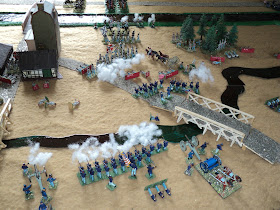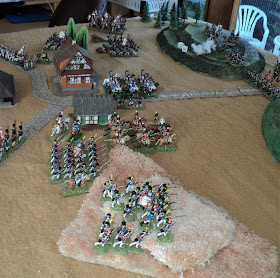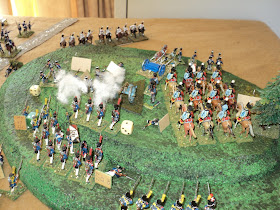 |
| Union cavalry patrol (top centre) finds a ford over the river... |
Continuing from last time, a Union force under Brig-Gen Justin Cayce has been ordered to clear the road north in pursuit of a retreating Rebel army. Approaching the village of Torkville, lying within the confluence of Nesmith Creek and the Dolenz River, they found a Confederate rearguard ready to contest their further advance.
 |
| Confederates open fire at long range as the Union troops approach. The dice are explained in the text. |
Advancing straight up the main road, 15th Kentucky was the first to feel the weight of Rebel fire.
(At this point I left the dice on table to illustrate my method of shooting. As the Kentuckians had moved, they were not able to return fire - not yet.
Both 18th S.C. and the Palmetto Battery (12pr Smoothbores) were shooting at the same target, their fire has to be adjudicated together, not severally. At just beyond canister range, the artillery die range is 4 (DR=4). Infantry: 4-man volley groups are firing at 'long' range, the 3rd of 4 range bands, so their DR=2. Die Range defines the maximum dice scores that count; any higher roll is ignored.
In this case Palmetto Battery scores the maximum: 4. A 5 or 6 would have missed. Eighteenth South Carolina rolls 6 dice, with the scores you see in the picture: 1,1,2,5,6,6. Only the ones and twos count, for a total of 4 hits. Added to the artillery, this means 8 hits scored on 15th Kentucky.
 |
| Union troops close up to the creek. |
This is very good shooting, but 8 hits do not mean 8 casualties. Instead of saving rolls, I use a method vaguely similar to Charles Grant's from The War Game. The hits are grouped into eights, plus any remainder. In this case all 8 hits form one 'hit group'. As many dice were rolled, as you see in the bottom right of the picture above. For clarity I have laid the scores out in rows. Four rows: four casualties. What we are doing is counting the distinct scores and ignoring duplicates (one poor fellow took three hits). A group of eight does guarantee there will be duplicates, as the maximum 'casualties' will be 6. But I chose 8-hit groups (instead of 6-hit) to make 6 casualties from a given 'hit group' more likely, but also to 'smooth out' the 'discontinuity' where there are more than 8 (or 16) hits on a target.
Having taken more than 10% of its 27-figure strength in losses, the morale of 15th Kentucky is called into question. At this point, no modification is called for, Kentucky just have to beat a roll of '1'. They roll a '4', indicating their morale remained high. In view of their subsequent performance, they must have been a determined bunch!
 |
| Action has become general all along the line. |
I will continue the narrative as an action with just occasional diversions into game mechanics.
Advancing into the teeth of heavy Confederate fire, 15th Kentucky were soon giving back as good as they were getting. Battery A/ 10th US Artillery soon joined in. As the remainder of Cayce's troops drew up to the line of Nesmith Creek, the action spread from west to east, and became general all along the line. Sixth Alabama was quickly drawn out of reserve to support 26th S.C. contesting the east bridge crossing.
Advancing into the teeth of heavy Confederate fire, 15th Kentucky were soon giving back as good as they were getting. Battery A/ 10th US Artillery soon joined in. As the remainder of Cayce's troops drew up to the line of Nesmith Creek, the action spread from west to east, and became general all along the line. Sixth Alabama was quickly drawn out of reserve to support 26th S.C. contesting the east bridge crossing.
 |
| Sinister developments on the Confederate left flank, as a Battery of Napoleon cannon take up an enfilade position. |
Outnumbered as they were, the Rebels were feeling the heat badly enough, but sinister developments were taking place, appropriately enough, beyond their left flank, across the creek. A patrol from 8th US Cavalry had discovered a ford across the Dolenz River, close by the Nesmith Creek branch. As the Regulars called in their patrols, 27th Pennsylvania Cavalry were despatched post haste to effect a crossing there. Following them marched the 126th New York infantry. By this time, the Napoleons of 12th Vermont Artillery were unlimbering to enfilade the battle line of 6th Alabama.
 |
| 15th Kentucky fighting back hard! |
Meanwhile, 18th S.C. was not finding 15th Ky so easy to contain, the contest becoming a dire battle of attrition. In the above picture, both units, already reduced to 4 whole and 1 part volley group, roll 4 dice plus a 'fraction' (for each figure less than 4, the DR is reduced by 1). The Confederates roll a miserable 1 hit, the Union a very creditable 7! I don't recall whether at this range the DR was 2 or 3, but given the actual dice rolls it scarcely matters. At any rate, 1 hit is 1 casualty; 7 hits (the 'part' die roll counted) ... rather more! The South Carolinians are not having things all their own way!
 |
| If 18th South Carolina's shooting was dismal in the previous picture, 66th Ohio's is even worse! 29th Ohio, to their left, performs rather better... |
Although the Palmetto battery was helping all it could, the counter-battery from the rifled guns across the stream was becoming more than a nuisance. It was not long before the guns had perforce to limver up and make off. Meanwhile, the shooting by 66th Ohio in the above picture was about as effectual as that of 18th S.C. was being: a mere 1 hit from 6 rolls. (At 'long' range, with DR=2, the Statistical Expectation would be 3 hits. Theoretically you could get as many as 12, but that likelihood is almost vanishingly small: 46,655 to 1 against (gotta have my Mr Spock moment). Still, you have seen what 15th Kentucky managed with 4 and a bit dice!
In view of the developing menace beyond the Confederate left, Cobb's Legion was ordered to deal with the approaching Union cavalry. To do so, Lt-Col Scoones split his command in two. Detailing half his command to dismount and line the south bank of the river, he led the remainder across the bridge. He hoped that the combination of mounted and dismounted action would throw back the Union horse, and keep the north road open.
 |
| Cobb's Legion prepares to deal with the distant Union cavalry approaching along the north bank. |
 |
| General Justin Cayce takes a hit! |
It was about this juncture that the Union suffered a minor calamity: the wounding of General Cayce. In determining actual losses from hits received, multiple sixes appearing denotes the casualty is an officer i.e. must come from the HQ element. This can have an effect on command and possibly control. In this instance, 5 hits were registered on 66th Ohio. Rolling the 5 gave the scores you see in the picture below: 3 casualties. Now, a triple six signifies that any general with or within 5cm (2 inches) of the unit becomes a casualty. So, poor General Cayce is out of the action. To determine the severity of the wound, I rolled a 3 - moderately severe and incapacitating injury. For this particular action, this loss had no significance, but it ought (a) to have led to a morale check for 66th Ohio (3 casualties - over 10% - in effect although in fact it lost just 2 figures) and (b) placed all units temporarily 'out of command'.
 |
| Cobb's Legion splits in two: 10 figures to face the 15-strong Pennsylvanians, the remaining 13 figures line the south bank preparing for dismounted action. |
Under mounting pressure, the bridge defenders began to give back. 26th S.C. soon fell back in confusion, and before 11th Alabama, the reserve unit, could intervene, 66th Ohio was surging across the bridge to form a line beyond.
 |
| Supported by musketry from 66th Ohio, 29th Ohio storm across the east bridge. |
The firefight between 6th Alabama and 5th Ohio was decided in favour of the former. Having lost more than half their strength, the Ohioans fell back in only fairish order (50% loss forced a retreat, and a morale roll. The morale roll happened to be good, so they retired still in hand, facing the enemy. They counted as 'used up' and will remained henceforth out of the action). This success was costing 6th Alabama dear. Finding the galling flank fire from the Union guns firing down the length of their line too much to cope with as well, they faded back, though still under command, into the woods behind them. Although intending to continue fighting from its cover, they didn't stay there long, and eventually continued their move towards the north bridge.
 |
| Under heavy fire, 66th Ohio form line and establish a precarious bridgehead. |
Union pressure at the bridges gradually forced the Confederates to relinquish their defensive grip. First, the Palmetto battery, pounded by counter-battery fire from the Union artillery on the opposite bank, had limbered up and made off through the village. Shortly afterwards they could be seen crossing the north bridge, just behind the cavalry action that was then developing on the north bank.
 |
| The depleted Palmetto Artillery retire across the bridge as 27th Pa. Cav. run the gauntlet of carbine fire in its attempt to clear the road. |
Together with the 20pr Parrotts of the Montgomery Artillery, 11th Alabama were holding off 66th Ohio, though both were finding it hard to sustain the mutual mauling (both were having to take morale rolls, which by some miracle both were passing. The only unit so far to fail its morale had been the 26th S.C. which had since rallied and had been ordered to lead the general withdrawal from the field).
 |
| The Confederates have been driven from the banks of the creek. 18th Georgia is holding the village; 26 N.C. is beginning its withdrawal from the action |
Eighteenth S.C. had fallen back to the southern edge of the hamlet, where they hoped to use the cover of its fences and outbuildings to hold the further advance of the Federals up the main road. It was becoming clear that the whole rearguard position was becoming untenable. It remained for General Zebedee to bring off his command in good order, whilst continuing to impose a delay upon the assailants. A great deal depended upon the success of the cavalry action developing close by his escape route across the north bridge.
 |
| 126th New York crosses the ford. |
 |
| The fight for the 29th Ohio's bridgehead. The Union seems to be making good progress! |
Following up the Union cavalry, 126th New York was splashing across the ford and would soon be up with their mounted comrades. Behind 66th Ohio, the US regular cavalry was making ready to cross the east bridge, and up the main road, 15th Kentucky, still enthusiastic despite its losses so far, were about to storm across the west bridge, and into the village.
We'll leave the matter there, for now, with the Confederates, in danger of being cut off, under severe pressure everywhere, and having to face fresh US troops about to enter the fray. Added to that, not half the day had yet elapsed. Nightfall was still a long, long way off...
To be concluded...































